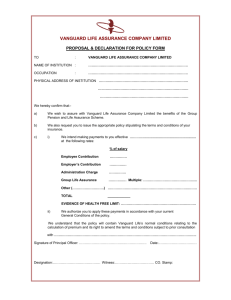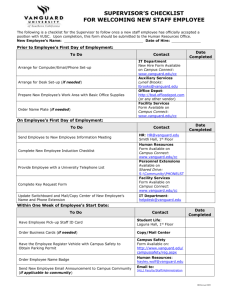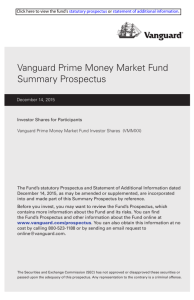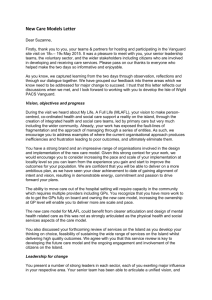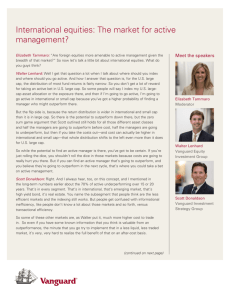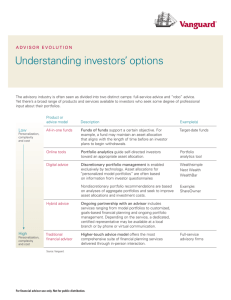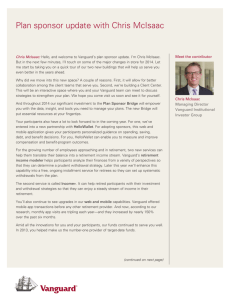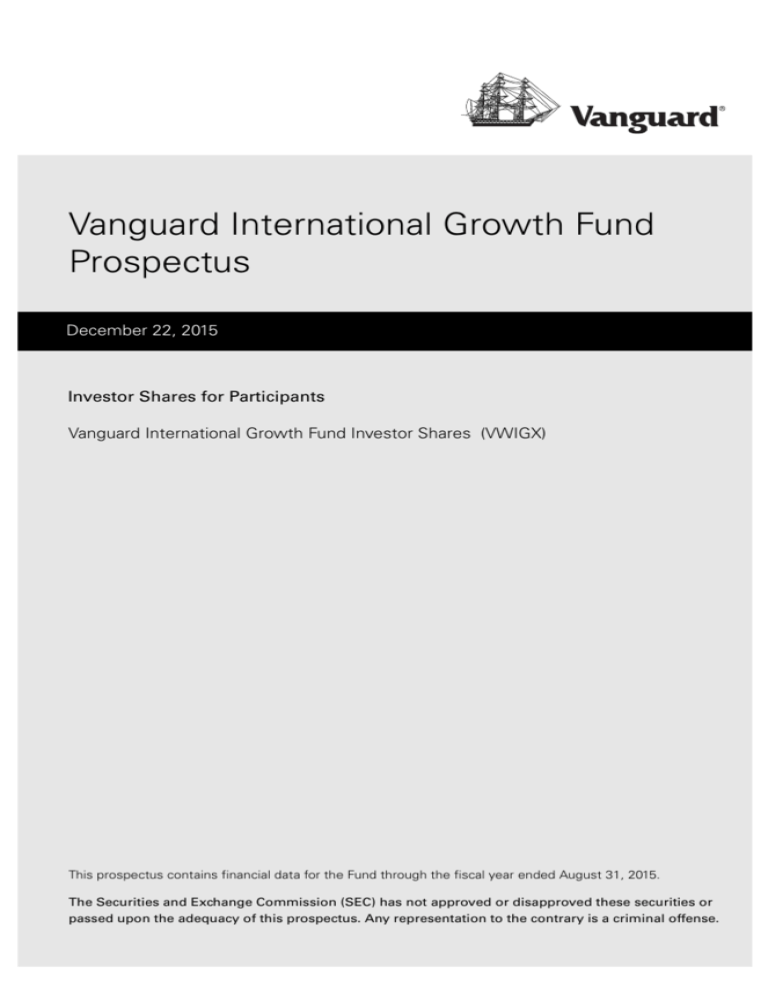
Vanguard International Growth Fund
Prospectus
December 22, 2015
Investor Shares for Participants
Vanguard International Growth Fund Investor Shares (VWIGX)
This prospectus contains financial data for the Fund through the fiscal year ended August 31, 2015.
The Securities and Exchange Commission (SEC) has not approved or disapproved these securities or
passed upon the adequacy of this prospectus. Any representation to the contrary is a criminal offense.
Contents
Fund Summary
1
Financial Highlights
20
More on the Fund
6
Investing With Vanguard
22
15
Accessing Fund Information Online
26
Glossary of Investment Terms
27
The Fund and Vanguard
Investment Advisors
16
Dividends, Capital Gains, and Taxes
18
Share Price
18
Fund Summary
Investment Objective
The Fund seeks to provide long-term capital appreciation.
Fees and Expenses
The following table describes the fees and expenses you may pay if you buy and hold
Investor Shares of the Fund.
Shareholder Fees
(Fees paid directly from your investment)
Sales Charge (Load) Imposed on Purchases
None
Purchase Fee
None
Sales Charge (Load) Imposed on Reinvested Dividends
None
Redemption Fee
None
Annual Fund Operating Expenses
(Expenses that you pay each year as a percentage of the value of your investment)
Management Fees
0.43%
12b-1 Distribution Fee
None
Other Expenses
0.04%
Total Annual Fund Operating Expenses
0.47%
1
Example
The following example is intended to help you compare the cost of investing in the
Fund’s Investor Shares with the cost of investing in other mutual funds. It illustrates
the hypothetical expenses that you would incur over various periods if you invested
$10,000 in the Fund’s shares. This example assumes that the Shares provide a return
of 5% each year and that total annual fund operating expenses remain as stated in the
preceding table. You would incur these hypothetical expenses whether or not you
redeem your investment at the end of the given period. Although your actual costs
may be higher or lower, based on these assumptions your costs would be:
1 Year
3 Years
5 Years
10 Years
$48
$151
$263
$591
Portfolio Turnover
The Fund pays transaction costs, such as commissions, when it buys and sells
securities (or “turns over” its portfolio). A higher portfolio turnover rate may indicate
higher transaction costs and may result in more taxes when Fund shares are held in a
taxable account. These costs, which are not reflected in annual fund operating
expenses or in the previous expense example, reduce the Fund’s performance. During
the most recent fiscal year, the Fund’s portfolio turnover rate was 29% of the average
value of its portfolio.
Principal Investment Strategies
The Fund invests predominantly in the stocks of companies located outside the
United States and is expected to diversify its assets in countries across developed
and emerging markets. In selecting stocks, the Fund’s advisors evaluate foreign
markets around the world and choose large-, mid-, and small-capitalization companies
considered to have above-average growth potential. The Fund uses multiple
investment advisors.
2
Principal Risks
An investment in the Fund could lose money over short or even long periods. You should
expect the Fund’s share price and total return to fluctuate within a wide range, like the
fluctuations of global stock markets. The Fund is subject to the following risks, which
could affect the Fund’s performance:
• Investment style risk, which is the chance that returns from non-U.S. growth stocks
and, to the extent that the Fund is invested in them, small- and mid-cap stocks, will
trail returns from global stock markets. Historically, non-U.S. small- and mid-cap stocks
have been more volatile in price than the large-cap stocks that dominate the global
markets, and they often perform quite differently.
• Stock market risk, which is the chance that stock prices overall will decline. Stock
markets tend to move in cycles, with periods of rising prices and periods of falling
prices. The Fund’s investments in foreign stocks can be riskier than U.S. stock
investments. Foreign stocks tend to be more volatile and less liquid than U.S. stocks.
The prices of foreign stocks and the prices of U.S. stocks may move in opposite
directions.
• Country/regional risk, which is the chance that world events—such as political upheaval,
financial troubles, or natural disasters—will adversely affect the value of securities issued
by companies in foreign countries or regions. Because the Fund may invest a large portion
of its assets in securities of companies located in any one country or region, including
emerging markets, the Fund’s performance may be hurt disproportionately by the poor
performance of its investments in that area. Country/regional risk is especially high in
emerging markets.
• Currency risk, which is the chance that the value of a foreign investment, measured in
U.S. dollars, will decrease because of unfavorable changes in currency exchange rates.
Currency risk is especially high in emerging markets.
• Manager risk, which is the chance that poor security selection will cause the Fund to
underperform relevant benchmarks or other funds with a similar investment objective. In
addition, significant investment in the financial sector subjects the Fund to
proportionately higher exposure to the risks of this sector.
An investment in the Fund is not a deposit of a bank and is not insured or guaranteed
by the Federal Deposit Insurance Corporation or any other government agency.
3
Annual Total Returns
The following bar chart and table are intended to help you understand the risks of
investing in the Fund. The bar chart shows how the performance of the Fund‘s
Investor Shares has varied from one calendar year to another over the periods shown.
The table shows how the average annual total returns of the Investor Shares compare
with those of relevant market indexes, which have investment characteristics similar
to those of the Fund. Returns for the indexes shown are adjusted for withholding
taxes. Keep in mind that the Fund’s past performance does not indicate how the Fund
will perform in the future. Updated performance information is available on our
website at vanguard.com/performance or by calling Vanguard toll-free at 800-662-7447.
Annual Total Returns — Vanguard International Growth Fund Investor Shares1
2005
2006
2007
2008
60%
2010
2011
2012
2013
20.01
22.95
2014
41.63
40%
20%
2009
15.00
25.92
15.98
15.66
0%
-20%
-5.63
-13.68
-40%
-60%
-44.94
1 The year-to-date return as of the most recent calendar quarter, which ended on September 30, 2015, was –7.20%.
During the periods shown in the bar chart, the highest return for a calendar quarter
was 27.03% (quarter ended June 30, 2009), and the lowest return for a quarter was
–23.22% (quarter ended December 31, 2008).
Average Annual Total Returns for Periods Ended December 31, 2014
1 Year
Vanguard International Growth Fund Investor Shares
5 Years
10 Years
–5.63%
6.81%
6.18%
MSCI ACWI ex USA Index
–3.87%
4.43%
5.13%
Spliced International Index
–3.87
3.85
3.70
Comparative Indexes
(reflect no deduction for fees or expenses)
4
Investment Advisors
Baillie Gifford Overseas Ltd. (Baillie Gifford)
M&G Investment Management Limited (M&G)
Schroder Investment Management North America Inc. (Schroders)
Portfolio Managers
James K. Anderson, Partner of Baillie Gifford & Co., which is the 100% owner of Baillie
Gifford, and Head of Global Equities. He has managed a portion of the Fund since 2003
(co-managed since 2013).
Kave Sigaroudinia, Partner of Baillie Gifford & Co., which is the 100% owner of Baillie
Gifford. He has co-managed a portion of the Fund since 2013.
Charles Anniss, CFA, Portfolio Manager at M&G. He has managed a portion of the
Fund since 2014.
Simon Webber, CFA, Portfolio Manager at Schroders. He has managed a portion of the
Fund since 2009.
Tax Information
The Fund’s distributions will be reinvested in additional Fund shares and accumulate on
a tax-deferred basis if you are investing through an employer-sponsored retirement or
savings plan. You will not owe taxes on these distributions until you begin withdrawals
from the plan. You should consult your plan administrator, your plan’s Summary Plan
Description, or your tax advisor about the tax consequences of plan withdrawals.
Payments to Financial Intermediaries
The Fund and its investment advisors do not pay financial intermediaries for sales of
Fund shares.
5
More on the Fund
This prospectus describes the principal risks you would face as a Fund shareholder. It
is important to keep in mind one of the main axioms of investing: generally, the higher
the risk of losing money, the higher the potential reward. The reverse, also, is
generally true: the lower the risk, the lower the potential reward. As you consider an
investment in any mutual fund, you should take into account your personal tolerance
for fluctuations in the securities markets. Look for this
symbol throughout the
prospectus. It is used to mark detailed information about the more significant risks
that you would confront as a Fund shareholder. To highlight terms and concepts
important to mutual fund investors, we have provided Plain Talk® explanations along
the way. Reading the prospectus will help you decide whether the Fund is the right
investment for you. We suggest that you keep this prospectus for future reference.
This prospectus offers the Fund‘s Investor Shares and is intended for participants in
employer-sponsored retirement or savings plans. Another version—for investors
who would like to open a personal investment account—can be obtained by visiting
our website at vanguard.com or by calling Vanguard at 800-662-7447.
Plain Talk About Fund Expenses
All mutual funds have operating expenses. These expenses, which are deducted
from a fund’s gross income, are expressed as a percentage of the net assets of
the fund. Assuming that operating expenses remain as stated in the Fees and
Expenses section, Vanguard International Growth Fund Investor Shares’ expense
ratio would be 0.47%, or $4.70 per $1,000 of average net assets. The average
expense ratio for international funds in 2014 was 1.39%, or $13.90 per $1,000 of
average net assets (derived from data provided by Lipper, a Thomson Reuters
Company, which reports on the mutual fund industry).
Plain Talk About Costs of Investing
Costs are an important consideration in choosing a mutual fund. That is because
you, as a shareholder, pay a proportionate share of the costs of operating a fund,
plus any transaction costs incurred when the fund buys or sells securities. These
costs can erode a substantial portion of the gross income or the capital
appreciation a fund achieves. Even seemingly small differences in expenses can,
over time, have a dramatic effect on a fund‘s performance.
6
The following sections explain the principal investment strategies and policies that the
Fund uses in pursuit of its objective. The Fund‘s board of trustees, which oversees the
Fund‘s management, may change investment strategies or policies in the interest of
shareholders without a shareholder vote, unless those strategies or policies are
designated as fundamental.
Market Exposure
The Fund invests mainly in common stocks of non-U.S. companies that are considered
to have above-average potential for growth. The asset-weighted median market
capitalization of the Fund’s stock holdings as of August 31, 2015, was $30.6 billion.
The Fund is subject to investment style risk, which is the chance that returns
from non-U.S. growth stocks and, to the extent that the Fund is invested in
them, small- and mid-cap stocks, will trail returns from global stock markets.
Historically, non-U.S. small- and mid-cap stocks have been more volatile in
price than the large-cap stocks that dominate the global markets, and they
often perform quite differently.
Plain Talk About Growth Funds and Value Funds
Growth investing and value investing are two styles employed by stock-fund
managers. Growth funds generally focus on stocks of companies believed to
have above-average potential for growth in revenue, earnings, cash flow, or other
similar criteria. These stocks typically have low dividend yields and above-average
prices in relation to measures such as earnings and book value. Value funds
typically emphasize stocks whose prices are below average in relation to those
measures; these stocks often have above-average dividend yields. Value stocks
also may remain undervalued by the market for long periods of time. Growth and
value stocks have historically produced similar long-term returns, though each
style has periods when it outperforms the other.
The Fund is subject to stock market risk, which is the chance that stock prices
overall will decline. Stock markets tend to move in cycles, with periods of rising
prices and periods of falling prices. The Fund‘s investments in foreign stocks can
be riskier than U.S. stock investments. Foreign stocks tend to be more volatile
and less liquid than U.S. stocks. The prices of foreign stocks and the prices of
U.S. stocks may move in opposite directions.
7
To illustrate the volatility of foreign stock prices, the following table shows the best,
worst, and average annual total returns for foreign stock markets over various periods
as measured by the MSCI EAFE Index, a widely used barometer of foreign market
activity. (Total returns consist of dividend income plus change in market price.) Note
that the returns shown do not include the costs of buying and selling stocks or other
expenses that a real-world investment portfolio would incur.
Foreign Stock Market Returns
(1970–2014)
1 Year
Best
Worst
Average
69.4%
5 Years
36.1%
10 Years
22.0%
20 Years
15.5%
–43.4
–4.7
0.8
3.1
11.3
9.7
10.2
10.3
The table covers all of the 1-, 5-, 10-, and 20-year periods from 1970 through 2014.
These average annual returns reflect past performance of foreign stocks; you should
not regard them as an indication of future performance of either foreign markets as a
whole or the Fund in particular.
Note that the MSCI EAFE Index does not take into account returns for emerging
markets, which can be substantially more volatile and substantially less liquid than the
more developed markets included in the Index. In addition, because the MSCI EAFE
Index tracks the European and Pacific developed markets collectively, the returns in
the preceding table do not reflect the variability of returns for these markets
individually. To illustrate this variability, the following table shows returns for different
foreign markets—as well as for the U.S. market for comparison—from 2005 through
2014, as measured by their respective indexes.
8
Returns for Various Stock Markets1
European
Market2
2005
9.42%
Pacific
Market2
Emerging
Markets2
U.S.
Market
22.64%
34.00%
2006
33.72
12.20
32.17
15.79
4.91%
2007
13.86
5.30
39.39
5.49
2008
–46.42
–36.42
–53.33
–37.00
2009
35.83
24.18
78.51
26.46
2010
3.88
15.92
18.88
15.06
2011
–11.06
–13.74
–18.42
2.11
2012
19.12
14.42
18.22
16.00
2013
25.23
18.27
–3.79
32.39
2014
–6.18
–2.70
–2.19
13.69
1 European market returns are measured by the MSCI Europe Index, Pacific market returns are measured by the MSCI Pacific
Index, emerging markets returns are measured by the MSCI Emerging Markets Index, and U.S. market returns are measured
by the S&P 500 Index.
2 MSCI Index returns reflect the reinvestment of cash dividends after deduction of withholding tax by applying the maximum
rate of the company’s country of incorporation applicable to institutional investors.
Keep in mind that these returns reflect past performance of the various indexes; you
should not consider them as an indication of future performance of the indexes or of
the Fund in particular.
The Fund is subject to country/regional risk and currency risk. Country/regional
risk is the chance that world events—such as political upheaval, financial
troubles, or natural disasters—will adversely affect the value of securities
issued by companies in foreign countries or regions. Because the Fund may
invest a large portion of its assets in securities of companies located in any one
country or region, including emerging markets, the Fund‘s performance may be
hurt disproportionately by the poor performance of its investments in that area.
Currency risk is the chance that the value of a foreign investment, measured in
U.S. dollars, will decrease because of unfavorable changes in currency
exchange rates. Country/regional risk and currency risk are especially high in
emerging markets.
9
Plain Talk About International Investing
U.S. investors who invest abroad will encounter risks not typically associated
with U.S. companies because foreign stock and bond markets operate differently
from the U.S. markets. For instance, foreign companies and governments are not
subject to the same accounting, auditing, and financial-reporting standards and
practices as U.S. companies and the U.S. government, and their stocks and
bonds may not be as liquid as those of similar U.S. entities. In addition, foreign
stock exchanges, brokers, companies, bond markets, and dealers may be subject
to less government supervision and regulation than their counterparts in the
United States. These factors, among others, could negatively affect the returns
U.S. investors receive from foreign investments.
Security Selection
The Fund uses multiple investment advisors. Each advisor independently selects and
maintains a portfolio of common stocks for the Fund.
Each advisor employs active investment management methods, which means that
securities are bought and sold according to the advisor’s evaluations of companies
and their financial prospects, the prices of the securities, and the stock market and
the economy in general. Each advisor will sell a security when, in the view of the
advisor, it is no longer as attractive as an alternative investment. Different advisors
may reach different conclusions on the same security.
Baillie Gifford Overseas Ltd. (Baillie Gifford) follows an investment approach based on
making long-term investments in well-researched and well-managed businesses with
above average growth potential.
Baillie Gifford analyzes a company’s ability to grow at an above average rate by
considering the industry in which it operates, any sustainable competitive advantages
the company has within that industry, the ability of management to execute on the
market opportunity before them, and whether the company can fund growth with
internally generated cash flows. Baillie Gifford also considers the valuation of the
company to understand the extent to which the market has already appreciated these
factors. Historically, Baillie Gifford has been willing to pay a premium for companies it
believes can deliver superior growth.
Schroder Investment Management North America Inc. (Schroders) seeks to invest in
securities of international companies where it has identified a significant growth gap,
which is defined as forward earnings growth that is not yet recognized by the market.
Schroders believes that market inefficiencies often drive material differences between
underlying company fundamentals and market estimates. The advisor also believes
in-depth fundamental research, incorporating a comprehensive macroeconomic
10
viewpoint and a robust framework of fundamental risk analysis, is the most reliable
means of finding those companies and identifying the growth gap. Schroders
leverages the extensive knowledge of, and recommendations generated by,
approximately 70 regional analysts located across the globe. The strongest ideas of
these local analysts are then overlaid with the global perspective of an international
team of global sector specialists. In Schroders’ view, this combination of local expertise
and global analysis provides an optimal framework for identifying strong investment
candidates and building high-quality efficient portfolios across multiple regions and
sectors. While the input of the team’s global sector specialists is an important source
of investment ideas and research, the investment “decision making” for the portion of
the Fund managed by Schroders rests with the portfolio manager.
M&G Investment Management Limited (M&G) uses a long-term, bottom-up approach
to portfolio management that focuses on attractively valued quality companies with
(1) competitive advantages that may protect their profitability and (2) positive internal
and external dynamics helping to grow the value of the business.
The team seeks to identify companies that fall into one of two categories: ‘sustainable
returns’ — high quality companies with competitive advantages that may support
sustainable superior returns; ‘improving returns’ — companies that are in the process
of becoming ‘sustainable returns’ businesses, but have the potential to further
optimize returns and grow the value of the business.
The Fund is subject to manager risk, which is the chance that poor security
selection will cause the Fund to underperform relevant benchmarks or other
funds with a similar investment objective. In addition, significant investment in
the financial sector subjects the Fund to proportionately higher exposure to the
risks of this sector.
Other Investment Policies and Risks
In addition to investing in stocks of foreign companies, the Fund may make other
kinds of investments to achieve its objective.
The Fund may invest in foreign issuers through American Depositary Receipts (ADRs),
European Depositary Receipts (EDRs), Global Depositary Receipts (GDRs), or similar
investment vehicles. The Fund may also invest in convertible securities.
The Fund may invest, to a limited extent, in derivatives. Generally speaking, a
derivative is a financial contract whose value is based on the value of a financial asset
(such as a stock, a bond, or a currency), a physical asset (such as gold, oil, or wheat), a
market index (such as the S&P 500 Index), or a reference rate (such as LIBOR).
Investments in derivatives may subject the Fund to risks different from, and possibly
greater than, those of investments directly in the underlying securities, assets, or
11
market indexes. The Fund will not use derivatives for speculation or for the purpose of
leveraging (magnifying) investment returns.
The Fund may enter into foreign currency exchange forward contracts, which are a
type of derivative. A foreign currency exchange forward contract is an agreement to
buy or sell a country’s currency at a specific price on a specific date, usually 30, 60, or
90 days in the future. In other words, the contract guarantees an exchange rate on a
given date. Advisors of funds that invest in foreign securities can use these contracts
to guard against unfavorable changes in currency exchange rates. These contracts,
however, would not prevent the Fund‘s securities from falling in value as a result of
risks other than unfavorable currency exchange movements.
Plain Talk About Derivatives
Derivatives can take many forms. Some forms of derivatives—such as exchangetraded futures and options on securities, commodities, or indexes—have been
trading on regulated exchanges for decades. These types of derivatives are
standardized contracts that can easily be bought and sold and whose market
values are determined and published daily. Non-exchange-traded derivatives (such
as certain swap agreements and foreign currency exchange forward contracts),
on the other hand, tend to be more specialized or complex and may be harder
to value.
The Vanguard Group, Inc. (Vanguard), administers a small portion of the Fund‘s assets
to facilitate cash flows to and from the Fund‘s advisors. Vanguard typically invests
these assets in stock index futures, which are a type of derivative, and/or shares of
exchange-traded funds (ETFs), including ETF Shares issued by Vanguard stock funds.
These stock index futures and ETFs typically provide returns similar to those of
common stocks. Vanguard may also purchase futures or ETFs when doing so will
reduce the Fund‘s transaction costs or add value because the instruments are
favorably priced. Vanguard receives no additional revenue from Fund assets invested
in ETF Shares of other Vanguard funds. Fund assets invested in ETF Shares are
excluded when allocating to the Fund its share of the costs of Vanguard operations.
12
Cash Management
The Fund‘s daily cash balance may be invested in one or more Vanguard CMT Funds,
which are very low-cost money market funds. When investing in a Vanguard CMT
Fund, the Fund bears its proportionate share of the expenses of the CMT Fund in
which it invests. Vanguard receives no additional revenue from Fund assets invested
in a Vanguard CMT Fund.
Temporary Investment Measures
The Fund may temporarily depart from its normal investment policies and strategies
when an advisor believes that doing so is in the Fund‘s best interest, so long as the
alternative is consistent with the Fund‘s investment objective. For instance, the Fund
may invest beyond its normal limits in derivatives or exchange-traded funds that are
consistent with the Fund‘s objective when those instruments are more favorably
priced or provide needed liquidity, as might be the case if the Fund is transitioning
assets from one advisor to another or receives large cash flows that it cannot
prudently invest immediately.
In addition, the Fund may take temporary defensive positions that are inconsistent
with its normal investment policies and strategies—for instance, by allocating
substantial assets to cash equivalent investments or other less volatile instruments—
in response to adverse or unusual market, economic, political, or other conditions. In
doing so, the Fund may succeed in avoiding losses but may otherwise fail to achieve
its investment objective.
Frequent Trading or Market-Timing
Background. Some investors try to profit from strategies involving frequent trading of
mutual fund shares, such as market-timing. For funds holding foreign securities,
investors may try to take advantage of an anticipated difference between the price of
the fund’s shares and price movements in overseas markets, a practice also known as
time-zone arbitrage. Investors also may try to engage in frequent trading of funds
holding investments such as small-cap stocks and high-yield bonds. As money is
shifted into and out of a fund by a shareholder engaging in frequent trading, the fund
incurs costs for buying and selling securities, resulting in increased brokerage and
administrative costs. These costs are borne by all fund shareholders, including the
long-term investors who do not generate the costs. In addition, frequent trading may
interfere with an advisor’s ability to efficiently manage the fund.
Policies to address frequent trading. The Vanguard funds (other than money market
funds and short-term bond funds, but including Vanguard Short-Term InflationProtected Securities Index Fund) do not knowingly accommodate frequent trading. The
board of trustees of each Vanguard fund (other than money market funds and shortterm bond funds, but including Vanguard Short-Term Inflation-Protected Securities
13
Index Fund) has adopted policies and procedures reasonably designed to detect and
discourage frequent trading and, in some cases, to compensate the fund for the costs
associated with it. These policies and procedures do not apply to Vanguard ETF®
Shares because frequent trading in ETF Shares generally does not disrupt portfolio
management or otherwise harm fund shareholders. Although there is no assurance
that Vanguard will be able to detect or prevent frequent trading or market-timing in all
circumstances, the following policies have been adopted to address these issues:
• Each Vanguard fund reserves the right to reject any purchase request—including
exchanges from other Vanguard funds—without notice and regardless of size. For
example, a purchase request could be rejected because the investor has a history of
frequent trading or if Vanguard determines that such purchase may negatively affect a
fund’s operation or performance.
• Each Vanguard fund (other than money market funds and short-term bond funds,
but including Vanguard Short-Term Inflation-Protected Securities Index Fund) generally
prohibits, except as otherwise noted in the Investing With Vanguard section,
a participant from exchanging into a fund account for 60 calendar days (30 calendar
days for investors other than participants in employer-sponsored defined contribution
plans recordkept directly by Vanguard) after the participant has exchanged out of that
fund account.
• Certain Vanguard funds charge shareholders purchase and/or redemption fees
on transactions.
See the Investing With Vanguard section of this prospectus for further details on
Vanguard’s transaction policies.
Each Vanguard fund (other than money market funds), in determining its net asset
value, will use fair-value pricing when appropriate, as described in the Share Price
section. Fair-value pricing may reduce or eliminate the profitability of certain frequenttrading strategies.
Do not invest with Vanguard if you are a market-timer.
Turnover Rate
Although the Fund generally seeks to invest for the long term, it may sell securities
regardless of how long they have been held. The Financial Highlights section of
this prospectus shows historical turnover rates for the Fund. A turnover rate of
100%, for example, would mean that the Fund had sold and replaced securities
valued at 100% of its net assets within a one-year period. The average turnover rate
for international stock funds was approximately 65%, as reported by Morningstar,
Inc., on August 31, 2015.
14
Plain Talk About Turnover Rate
Before investing in a mutual fund, you should review its turnover rate. This gives
an indication of how transaction costs, which are not included in the fund’s
expense ratio, could affect the fund’s future returns. In general, the greater the
volume of buying and selling by the fund, the greater the impact that brokerage
commissions and other transaction costs will have on its return. Also, funds with
high turnover rates may be more likely to generate capital gains, including shortterm capital gains, that must be distributed to shareholders.
The Fund and Vanguard
The Fund is a member of The Vanguard Group, a family of more than 190 mutual
funds holding assets of approximately $2.9 trillion. All of the funds that are members
of The Vanguard Group (other than funds of funds) share in the expenses associated
with administrative services and business operations, such as personnel, office
space, and equipment.
Vanguard Marketing Corporation provides marketing services to the funds. Although
shareholders do not pay sales commissions or 12b-1 distribution fees, each fund (other
than a fund of funds) or each share class of a fund (in the case of a fund with multiple
share classes) pays its allocated share of the Vanguard funds’ marketing costs.
Plain Talk About Vanguard’s Unique Corporate Structure
The Vanguard Group is truly a mutual mutual fund company. It is owned jointly by
the funds it oversees and thus indirectly by the shareholders in those funds.
Most other mutual funds are operated by management companies that may be
owned by one person, by a private group of individuals, or by public investors
who own the management company’s stock. The management fees charged by
these companies include a profit component over and above the companies’ cost
of providing services. By contrast, Vanguard provides services to its member
funds on an at-cost basis, with no profit component, which helps to keep the
funds’ expenses low.
15
Investment Advisors
The Fund uses a multimanager approach. Each advisor independently manages its
assigned portion of the Fund’s assets, subject to the supervision and oversight of
Vanguard and the Fund’s board of trustees. The board of trustees designates the
proportion of the Fund assets to be managed by each advisor and may change these
proportions at any time.
• Baillie Gifford Overseas Ltd. (Baillie Gifford), Calton Square, 1 Greenside Row,
Edinburgh, EH1 3AN, Scotland, is an investment advisory firm founded in 1983. Baillie
Gifford Overseas Ltd. is wholly owned by a Scottish investment company, Baillie
Gifford & Co. Founded in 1908, Baillie Gifford & Co., one of the largest independently
owned investment management firms in the United Kingdom, manages money
primarily for institutional clients. Baillie Gifford began managing a portion of the Fund
in 2003. Baillie Gifford & Co. had assets under management that totaled
approximately $168 billion as of August 31, 2015.
• M&G Investment Management Limited (M&G), Laurence Pountney Hill, London,
EC4R 0HH, England, is an advisory firm and wholly owned subsidiary of the Prudential
plc. M&G is a company incorporated in the United Kingdom, based in London,
England, and is not affiliated in any manner with Prudential Financial, Inc., a company
whose principal place of business is in the United States. M&G, a separate business
unit within the Prudential group, launched Great Britain’s first unit trust (mutual fund)
in 1931. M&G began managing a portion of the Fund in 2008. As of August 31, 2015,
M&G managed approximately $375 billion in assets.
• Schroder Investment Management North America Inc. (Schroders), 875 Third
Avenue, 22nd Floor, New York, NY 10022-6225, is a registered investment advisor that
is part of a worldwide group of financial services companies that are wholly owned by
Schroders plc. Schroders currently serves as investment advisor to the Fund, other
mutual funds, and a broad range of institutional investors. As of August 31, 2015,
Schroders plc, through its affiliates, managed approximately $487 billion in assets.
Schroder Investment Management North America Ltd. (Schroder Limited), 31
Gresham Street, London, EC2V 7QA, England, serves as the sub-advisor for the
Schroders portion of the Fund.
The Fund pays each of its investment advisors a base fee plus or minus a performance
adjustment. Each base fee, which is paid quarterly, is a percentage of average daily net
assets managed by the advisor during the most recent fiscal quarter. The base fee has
breakpoints, which means that the percentage declines as assets go up. The
performance adjustment, also paid quarterly, is based on the cumulative total return of
each advisor’s portion of the Fund relative to that of the MSCI ACWI ex USA Index over
the preceding 36-month period. When the performance adjustment is positive, the
Fund’s expenses increase; when it is negative, expenses decrease.
16
Schroders pays 59% of its advisory fee to Schroder Limited for providing
sub-advisory services.
For the fiscal year ended August 31, 2015, the aggregate advisory fee represented an
effective annual rate of 0.15% of the Fund’s average net assets before a performancebased increase of 0.03%.
Under the terms of an SEC exemption, the Fund’s board of trustees may, without prior
approval from shareholders, change the terms of an advisory agreement or hire a new
investment advisor—either as a replacement for an existing advisor or as an additional
advisor. Any significant change in the Fund’s advisory arrangements will be
communicated to shareholders in writing. In addition, as the Fund’s sponsor and
overall manager, Vanguard may provide investment advisory services to the Fund, on
an at-cost basis, at any time. Vanguard may also recommend to the board of trustees
that an advisor be hired, terminated, or replaced or that the terms of an existing
advisory agreement be revised.
For a discussion of why the board of trustees approved the Fund’s investment
advisory agreements, see the most recent semiannual report to shareholders
covering the fiscal period ended February 28.
The managers primarily responsible for the day-to-day management of the Fund are:
James K. Anderson, Partner of Baillie Gifford & Co., which is the 100% owner of Baillie
Gifford, and Head of Global Equities. He has managed assets with Baillie Gifford since
1985 and has managed a portion of the Fund since 2003 (co-managed since 2013).
Education: B.A., University College, Oxford; Diploma, Bologna Center of The Johns
Hopkins University; M.A., Carleton Ottawa University.
Kave Sigaroudinia, Partner of Baillie Gifford & Co., which is the 100% owner of Baillie
Gifford. He has worked in investment management with Baillie Gifford since 1999, has
managed investment portfolios since 2001, and has co-managed a portion of the Fund
since 2013. Education: M.A., University of Edinburgh.
Charles Anniss, CFA, Portfolio Manager at M&G. He has been with M&G since 2000,
has worked in investment management since 2003, has managed investment portfolios
since 2006, and has managed a portion of the Fund since 2014. Education: B.A., Bristol
University.
Simon Webber, CFA, Portfolio Manager at Schroders. He has worked in investment
management for Schroders since 1999, has managed assets since 2001, and has
managed a portion of the Fund since 2009. Education: B.Sc., University of Manchester.
The Statement of Additional Information provides information about each portfolio
manager’s compensation, other accounts under management, and ownership of
shares of the Fund.
17
Dividends, Capital Gains, and Taxes
The Fund distributes to shareholders virtually all of its net income (interest and
dividends, less expenses) as well as any net capital gains realized from the sale of its
holdings. Income and capital gains distributions, if any, generally occur annually
in December. In addition, the Fund may occasionally make a supplemental distribution
at some other time during the year.
Your distributions will be reinvested in additional Fund shares and accumulate on
a tax-deferred basis if you are investing through an employer-sponsored retirement or
savings plan. You will not owe taxes on these distributions until you begin withdrawals
from the plan. You should consult your plan administrator, your plan’s Summary Plan
Description, or your tax advisor about the tax consequences of plan withdrawals.
Plain Talk About Distributions
As a shareholder, you are entitled to your portion of a fund’s income from interest
and dividends as well as capital gains from the fund’s sale of investments.
Income consists of both the dividends that the fund earns from any stock
holdings and the interest it receives from any money market and bond
investments. Capital gains are realized whenever the fund sells securities for
higher prices than it paid for them.
Share Price
Share price, also known as net asset value (NAV), is calculated each business day as
of the close of regular trading on the New York Stock Exchange (NYSE), generally
4 p.m., Eastern time. Each share class has its own NAV, which is computed by dividing
the total assets, minus liabilities, allocated to the share class by the number of Fund
shares outstanding for that class. On U.S. holidays or other days when the NYSE is
closed, the NAV is not calculated, and the Fund does not sell or redeem shares.
However, on those days the value of the Fund’s assets may be affected to the extent
that the Fund holds securities that change in value on those days (such as foreign
securities that trade on foreign markets that are open).
Stocks held by a Vanguard fund are valued at their market value when reliable market
quotations are readily available from the principal exchange or market on which they
are traded. Such securities are generally valued at their official closing price, the last
reported sales price, or if there were no sales that day, the mean between the closing
bid and asking prices. Certain short-term debt instruments used to manage a fund’s
cash may be valued at amortized cost when it approximates fair value. The values of
any foreign securities held by a fund are converted into U.S. dollars using an exchange
rate obtained from an independent third party as of the close of regular trading on the
18
NYSE. The values of any mutual fund shares held by a fund are based on the NAVs of
the shares. The values of any ETF or closed-end fund shares held by a fund are based
on the market value of the shares.
When a fund determines that market quotations either are not readily available or do
not accurately reflect the value of a security, the security is priced at its fair value (the
amount that the owner might reasonably expect to receive upon the current sale of
the security). A fund also will use fair-value pricing if the value of a security it holds has
been materially affected by events occurring before the fund’s pricing time but after
the close of the principal exchange or market on which the security is traded. This
most commonly occurs with foreign securities, which may trade on foreign exchanges
that close many hours before the fund’s pricing time. Intervening events might be
company-specific (e.g., earnings report, merger announcement) or country-specific or
regional/global (e.g., natural disaster, economic or political news, act of terrorism,
interest rate change). Intervening events include price movements in U.S. markets
that exceed a specified threshold or that are otherwise deemed to affect the value of
foreign securities. Fair-value pricing may be used for domestic securities—for
example, if (1) trading in a security is halted and does not resume before the fund’s
pricing time or a security does not trade in the course of a day and (2) the fund holds
enough of the security that its price could affect the NAV.
Fair-value prices are determined by Vanguard according to procedures adopted by
the board of trustees. When fair-value pricing is employed, the prices of securities
used by a fund to calculate the NAV may differ from quoted or published prices for the
same securities.
Vanguard fund share prices are published daily on our website at vanguard.com/prices.
19
Financial Highlights
The following financial highlights table is intended to help you understand the Investor
Shares‘ financial performance for the periods shown, and certain information reflects
financial results for a single Investor Share. The total returns in the table represent the
rate that an investor would have earned or lost each period on an investment in the
Investor Shares (assuming reinvestment of all distributions). This information has
been obtained from the financial statements audited by PricewaterhouseCoopers LLP,
an independent registered public accounting firm, whose report—along with the
Fund’s financial statements—is included in the Fund’s most recent annual report to
shareholders. You may obtain a free copy of the latest annual or semiannual report by
visiting vanguard.com or by contacting Vanguard by telephone or mail.
Plain Talk About How to Read the Financial Highlights Table
The Investor Shares began fiscal year 2015 with a net asset value (share price) of
$23.79 per share. During the year, each Investor Share earned $0.308 from
investment income (interest and dividends). There was a decline of $2.774 per
share in the value of investments held or sold by the Fund, resulting in a net
decline of $2.466 per share from investment operations.
Shareholders received $0.494 per share in the form of dividend distributions. A
portion of each year’s distributions may come from the prior year’s income or
capital gains.
The share price at the end of the year was $20.83, reflecting losses of $2.466 per
share and distributions of $0.494 per share. This was a decrease of $2.96 per
share (from $23.79 at the beginning of the year to $20.83 at the end of the year).
For a shareholder who reinvested the distributions in the purchase of more
shares, the total return was -10.46% for the year.
As of August 31, 2015, the Investor Shares had approximately $7.2 billion in net
assets. For the year, the expense ratio was 0.47% ($4.70 per $1,000 of net
assets), and the net investment income amounted to 1.34% of average net
assets. The Fund sold and replaced securities valued at 29% of its net assets.
20
International Growth Fund Investor Shares
Year Ended August 31,
For a Share Outstanding Throughout Each Period
Net Asset Value, Beginning of Period
2015
2014
2013
2012
2011
$23.79
$20.42
$17.69
$18.27
$16.27
.336
.361
.351
Investment Operations
Net Investment Income
.308
.471 1
Net Realized and Unrealized Gain (Loss)
on Investments
(2.774)
3.235
2.741
(.607)
1.954
Total from Investment Operations
(2.466)
3.706
3.077
(.246)
2.305
(.494)
(.336)
(.347)
(.334)
(.305)
—
—
—
—
—
Distributions
Dividends from Net Investment Income
Distributions from Realized Capital Gains
Total Distributions
(.494)
(.336)
(.347)
(.334)
(.305)
$20.83
$23.79
$20.42
$17.69
$18.27
–10.46%
18.26%
17.54%
–1.14%
14.10%
Net Assets, End of Period (Millions)
$7,172
$8,976
$9,056
$9,115
$10,878
Ratio of Total Expenses to Average Net Assets3
0.47%
0.47%
0.48%
0.49%
0.47%
Ratio of Net Investment Income to Average
Net Assets
1.34%
2.08% 1
1.71%
2.04%
1.85%
31%
30%
43%
Net Asset Value, End of Period
Total Return2
Ratios/Supplemental Data
Portfolio Turnover Rate
29%
21%
1 Net investment income per share and the ratio of net investment income to average net assets include $0.080 and 0.35%,
respectively, resulting from income received from Vodafone Group plc in the form of cash and shares in Verizon
Communications Inc. in February 2014.
2 Total returns do not include transaction fees that may have applied in the periods shown.
3 Includes performance-based investment advisory fee increases (decreases) of 0.03%, 0.03%, 0.03%, 0.04%, and 0.03%.
21
Investing With Vanguard
The Fund is an investment option in your retirement or savings plan. Your plan
administrator or your employee benefits office can provide you with detailed
information on how to participate in your plan and how to elect the Fund as an
investment option.
• If you have any questions about the Fund or Vanguard, including those about the
Fund’s investment objective, strategies, or risks, contact Vanguard Participant
Services toll-free at 800-523-1188 or visit our website at vanguard.com.
• If you have questions about your account, contact your plan administrator or the
organization that provides recordkeeping services for your plan.
• Be sure to carefully read each topic that pertains to your transactions with Vanguard.
Vanguard reserves the right to change its policies without notice to shareholders.
Investment Options and Allocations
Your plan’s specific provisions may allow you to change your investment selections,
the amount of your contributions, or the allocation of your contributions among the
investment choices available to you. Contact your plan administrator or employee
benefits office for more details.
Transactions
Transaction requests (e.g., a contribution, an exchange, or a redemption) must be in
good order. Good order means that Vanguard has determined that (1) your transaction
request includes complete information and (2) appropriate assets are already in your
account or new assets have been received or, if funded via ACH, credited to
your account.
Processing times for your transaction requests may differ among recordkeepers or
among transaction and funding types. Your plan’s recordkeeper (which may also be
Vanguard) will determine the necessary processing time frames for your transaction
requests prior to submission to the Fund. Consult your recordkeeper or plan
administrator for more information.
Your transaction will then be based on the next-determined net asset value (NAV) of
the Fund‘s Investor Shares. If your transaction request is received in good order
before the close of regular trading on the New York Stock Exchange (NYSE) (generally
4 p.m., Eastern time), you will receive that day’s NAV and trade date. NAVs are
calculated only on days the NYSE is open for trading.
If Vanguard is serving as your plan recordkeeper and if your transaction involves one
or more investments with an early cut-off time for processing or another trading
restriction, your entire transaction will be subject to the restriction when the trade
date for your transaction is determined.
22
Frequent-Trading Limitations
The exchange privilege (your ability to purchase shares of a fund using the proceeds from
the simultaneous redemption of shares of another fund) may be available to you through
your plan. Although we make every effort to maintain the exchange privilege, Vanguard
reserves the right to revise or terminate this privilege, limit the amount of an exchange,
or reject any exchange, at any time, without notice. Because excessive exchanges can
disrupt the management of the Vanguard funds and increase their transaction costs,
Vanguard places certain limits on the exchange privilege.
If you are exchanging out of any Vanguard fund (other than money market funds and
short-term bond funds, but including Vanguard Short-Term Inflation-Protected
Securities Index Fund), you must wait 60 calendar days (30 calendar days for investors
other than participants in employer-sponsored defined contribution plans recordkept
directly by Vanguard) before exchanging back into the fund. This policy applies,
regardless of the dollar amount. Please note that the 60-day clock restarts after every
exchange out of the fund.
The frequent-trading limitations do not apply to the following: exchange requests
submitted by mail to Vanguard (exchange requests submitted by fax, if otherwise
permitted, are subject to the limitations); exchanges of shares purchased with
participant payroll or employer contributions or loan repayments; exchanges of shares
purchased with reinvested dividend or capital gains distributions; distributions, loans,
and in-service withdrawals from a plan; redemptions of shares as part of a plan
termination or at the direction of the plan; redemptions of shares to pay fund or
account fees; share or asset transfers or rollovers; reregistrations of shares within the
same fund; conversions of shares from one share class to another in the same fund;
and transactions executed through the Vanguard Managed Account Program.
Before making an exchange to or from another fund available in your plan, consider
the following:
• Certain investment options, particularly funds made up of company stock or
investment contracts, may be subject to unique restrictions.
• Vanguard can accept exchanges only as permitted by your plan. Contact your plan
administrator for details on other exchange policies that apply to your plan.
Before making an exchange into another fund, it is important to read that fund’s
prospectus. To obtain a copy, please contact Vanguard Participant Services toll-free
at 800-523-1188.
Plans for which Vanguard does not serve as recordkeeper: If Vanguard does not
serve as recordkeeper for your plan, your plan’s recordkeeper will establish accounts
in Vanguard funds for the benefit of its clients. In such accounts, we cannot always
monitor the trading activity of individual clients. However, we review trading activity at
the intermediary (omnibus) level, and if we detect suspicious activity, we will
23
investigate and take appropriate action. If necessary, Vanguard may prohibit additional
purchases of fund shares by an intermediary, including for the benefit of certain of the
intermediary’s clients. Intermediaries also may monitor participants’ trading activity
with respect to Vanguard funds.
For those Vanguard funds that charge purchase and/or redemption fees,
intermediaries that establish accounts in the Vanguard funds will be asked to assess
these fees on participant accounts and remit these fees to the funds. The application
of purchase and redemption fees and frequent-trading limitations may vary among
intermediaries. There are no assurances that Vanguard will successfully identify all
intermediaries or that intermediaries will properly assess purchase and redemption
fees or administer frequent-trading limitations. If a firm other than Vanguard serves as
recordkeeper for your plan, please read that firm’s materials carefully to learn of any
other rules or fees that may apply.
Investing With Vanguard Through Other Firms
You may purchase or sell shares of most Vanguard funds through a financial
intermediary, such as a bank, a broker, or an investment advisor. Please consult your
financial intermediary to determine which, if any, shares are available through that firm
and to learn about other rules that may apply. Your financial intermediary can provide
you with account information and any required tax forms.
No Cancellations
Vanguard will not accept your request to cancel any transaction request once
processing has begun. Please be careful when placing a transaction request.
Proof of a Caller’s Authority
We reserve the right to refuse a telephone request if the caller is unable to provide
the requested information or if we reasonably believe that the caller is not an
individual authorized to act on the account. Before we allow a caller to act on an
account, we may request the following information:
• Authorization to act on the account (as the account owner or by legal
documentation or other means).
• Account registration and address.
• Fund name and account number, if applicable.
• Other information relating to the caller, the account owner, or the account.
24
Uncashed Checks
Vanguard will not pay interest on uncashed checks. Vanguard may be required to
transfer assets related to uncashed checks to a state under the state’s abandoned
property law.
Portfolio Holdings
Please consult the Fund’s Statement of Additional Information or our website for a
description of the policies and procedures that govern disclosure of the Fund’s
portfolio holdings.
Additional Information
Inception Date
Newspaper
Abbreviation
Vanguard
Fund Number
CUSIP
Number
9/30/1981
IntlGr
81
921910204
International Growth Fund
Investor Shares
25
Accessing Fund Information Online
Vanguard Online at Vanguard.com
Visit Vanguard’s education-oriented website for access to timely news and information
about Vanguard funds and services and easy-to-use, interactive tools to help you
create your own investment and retirement strategies.
CFA® is a registered trademark owned by CFA Institute.
Morningstar data © 2015 Morningstar, Inc. All Rights Reserved. The information contained herein: (1) is proprietary to
Morningstar and/or its content providers; (2) may not be copied or distributed; and (3) is not warranted to be accurate,
complete or timely. Neither Morningstar nor its content providers are responsible for any damages or losses arising from any
use of this information. Past performance is no guarantee of future results.
26
Glossary of Investment Terms
Capital Gains Distribution. Payment to mutual fund shareholders of gains realized on
securities that a fund has sold at a profit, minus any realized losses.
Cash Equivalent Investments. Cash deposits, short-term bank deposits, and money
market instruments that include U.S. Treasury bills and notes, bank certificates of
deposit (CDs), repurchase agreements, commercial paper, and banker’s acceptances.
Common Stock. A security representing ownership rights in a corporation.
Dividend Distribution. Payment to mutual fund shareholders of income from interest
or dividends generated by a fund’s investments.
Expense Ratio. A fund’s total annual operating expenses expressed as a percentage
of the fund’s average net assets. The expense ratio includes management and
administrative expenses, but it does not include the transaction costs of buying and
selling portfolio securities.
Inception Date. The date on which the assets of a fund (or one of its share classes)
are first invested in accordance with the fund’s investment objective. For funds with a
subscription period, the inception date is the day after that period ends. Investment
performance is generally measured from the inception date.
Median Market Capitalization. An indicator of the size of companies in which a fund
invests; the midpoint of market capitalization (market price x shares outstanding) of a
fund’s stocks, weighted by the proportion of the fund’s assets invested in each stock.
Stocks representing half of the fund’s assets have market capitalizations above the
median, and the rest are below it.
MSCI ACWI ex USA Index. An index that tracks stock markets in countries included
in the MSCI EAFE Index plus Canada and a number of emerging markets, but
excluding the U.S.
Mutual Fund. An investment company that pools the money of many people and
invests it in a variety of securities in an effort to achieve a specific objective over time.
Securities. Stocks, bonds, money market instruments, and other investments.
27
Spliced International Index. An index that reflects performance of the MSCI EAFE
Index through May 31, 2010, and the MSCI ACWI ex USA Index thereafter.
Total Return. A percentage change, over a specified time period, in a mutual fund’s
net asset value, assuming the reinvestment of all distributions of dividends and
capital gains.
Volatility. The fluctuations in value of a mutual fund or other security. The greater a
fund’s volatility, the wider the fluctuations in its returns.
Yield. Income (interest or dividends) earned by an investment, expressed as a
percentage of the investment’s price.
28
This page intentionally left blank.
Institutional Division
P.O. Box 2900
Valley Forge, PA 19482-2900
Connect with Vanguard® > vanguard.com
For More Information
If you would like more information about Vanguard
International Growth Fund, the following documents
are available free upon request:
To receive a free copy of the latest annual or semiannual
report or the SAI, or to request additional information
about the Fund or other Vanguard funds, please visit
vanguard.com or contact us as follows:
Annual/Semiannual Reports to Shareholders
Additional information about the Fund’s investments is
available in the Fund’s annual and semiannual reports
to shareholders. In the annual report, you will find a
discussion of the market conditions and investment
strategies that significantly affected the Fund’s
performance during its last fiscal year.
The Vanguard Group
Participant Services
P.O. Box 2900
Valley Forge, PA 19482-2900
Telephone: 800-523-1188
Text telephone for people with hearing impairment:
800-749-7273
Statement of Additional Information (SAI)
The SAI provides more detailed information about the
Fund and is incorporated by reference into (and thus
legally a part of) this prospectus.
Information Provided by the Securities and
Exchange Commission (SEC)
You can review and copy information about the Fund
(including the SAI) at the SEC’s Public Reference Room
in Washington, DC. To find out more about this public
service, call the SEC at 202-551-8090. Reports and
other information about the Fund are also available in
the EDGAR database on the SEC’s website at
www.sec.gov, or you can receive copies of this
information, for a fee, by electronic request at the
following email address: publicinfo@sec.gov, or by
writing the Public Reference Section, Securities and
Exchange Commission, Washington, DC 20549-1520.
Fund’s Investment Company Act file number: 811-01027
© 2015 The Vanguard Group, Inc. All rights reserved.
Vanguard Marketing Corporation, Distributor.
I 081 122015

